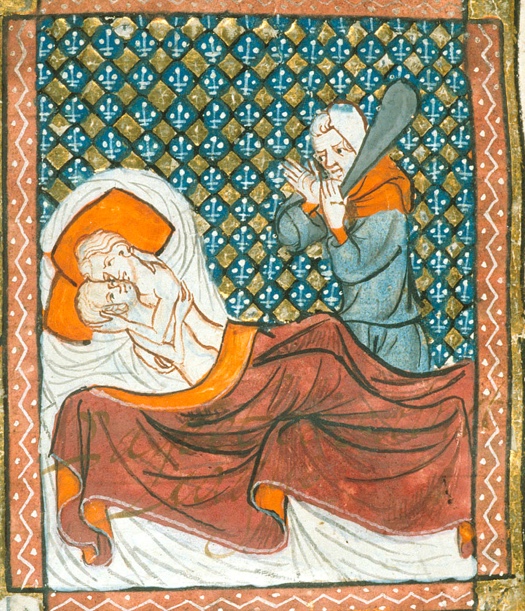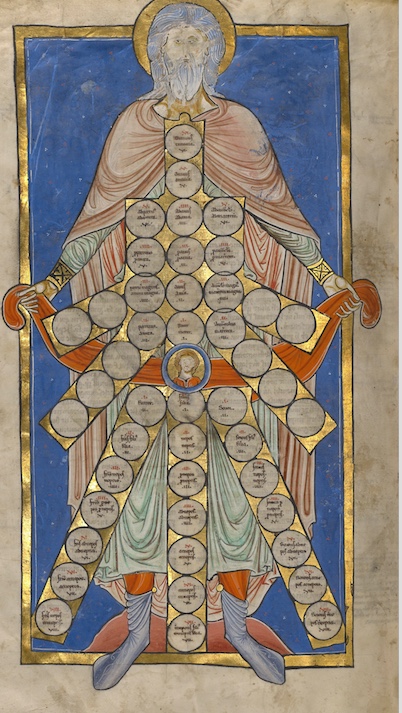The so called “dark ages” of the sixth to tenth centuries are often seen as a strange and obscure period of Western history, and one of the strangest phenomena of the period is the emergence of a new understanding of the concept of incest in the early sixth century that was swiftly legislated in both secular and canon law. Incest in modern law and culture refers to sexual contact between people who have a blood relationship: a sister, a father, a cousin. Sometimes, we might extend this to people who have a familial, but not technically a blood, relationship with a minor. Step-fathers, for example, or aunts by marriage. In the early middle ages, however, a bizarre phenomenon emerged in which affinity as well as consanguinity was considered to be a barrier to sexual or marital relations. This barred people from marrying their sister-in-law, their stepmother, their second cousin and so on, all with the justification that such relationships now constituted incest. In the eighth century, ‘spiritual kin’ were included under this incest umbrella, meaning that godparents and the relations of godparents were also made off limits. These provisions emerged as the kings and bishops of the Frankish churches appeared to develop an unexpected, and apparently entirely spontaneous, obsession with the concept of incest and enthusiastically applied it to a wider and wider range of personal relations. The spread of these incest laws across Europe shifted norms around family and marriage, introducing the instability of the age into the private realm.

The development of incest legislation in the Western church is remarkably clear and well documented, unusually so for the period. The first appearance of incest was in the canons of the Council of Orléans in AD 511, but it was in AD 517 that the first truly extensive canons on incest prohibitions were penned at the Burgundian Council of Epoan, led by Avitus of Vienne. This council issued canons which explicitly forbade marriage to a brother’s widow, a deceased wife’s sister, a mother-in-law, cousin, child of a cousin, an uncle’s widow (both paternal and maternal) and step-daughter. This was an extreme and unusual extension of the Roman provisions on consanguineous incest, and was derived from the commandment of Leviticus 18 6-18, which lists the blood relations with whom sexual relations would be considered incesutous. The final person in this list is “your wife’s sister,” but the prohibition is clearly against taking a second wife from the same family while the first wife is still living. The extension of Leviticus 18.18 to widows and widowers was unprecedented, and it seems that Avitus knew it.
Unexpectedly, the motivations for this sudden move are well documented in the letters of Avitus of Vienne in which he specifically refers to the case of Vincomalus and his wife (Letters 16-18). This case is dated to approximately AD 516, and, given Avitus’s prominent role in the Council of Epoan, is almost certainly the foundation for the canons of Epoan that sparked the interest in incest. Vincomalus was the bishop of Grenoble and had been reported to his superior, Victorius, as having married his deceased wife’s sister. Vincomalus had been married to this second wife for thirty years by the time it was reported and so Victorius was unsure of whether the marriage was problematic. He passed the issue further up the episcopal chain to Avitus, who pronounced clearly that the marriage was incestuous and must be ended. Vincomalus, unsurprisingly, refused to divorce his wife. Ian Wood proposed that a further case, documented in the Life of Avitus’s brother Apollinaris of Valence and concerning a certain Stephanus and his brother’s widow Palladia, was considered alongside Vincomalus’s case at Epoan, a proposition which suggests that the limits of acceptable sexual contact and the real world implications of theological thought were being debated across Gaul at the same time. These two very specific issues, sparked by anonymous informers who took sudden offence to the idea of marriage to a brother’s widow or sister’s widower, seem to have snowballed the issue of the nature of incest within the western church.
There were several more church councils that weighed in to reiterate these new provisions, and after the Second Council of Paris (556), incest legislation began to creep into the law codes of the early medieval kings, demonstrating the complex interplay between the Church as a repository of local power and the polycentric, relatively unstable courts of the post-Imperial west. The Merovingian kings Childebert and Chilperic II both issued laws confirming the canon law, and in the Visigothic kingdom that spanned Southwestern France and Iberia during the mid-seventh century Chindaswinth incorporated extensive prohibitions into the Visigothic law code as part of his legal reform. Interestingly, both these laws forbade marriage to anyone with whom an individual’s brother, father or son had had a sexual relationship. This greatly expanded the group to whom marriage is forbidden, and added an extra layer in considering sexual relationships as on a par (regarding incest at least) with marriage. In the law of the Ripuarian Franks of the Rhineland at the same time, provisions for incest of this type became punishable with death.
It was not until the eighth century that papal authority began to consider the issue, due to the weakness of the pope in this period. In AD 721, however, a papal ban was issued by Gregory II at the Synod of Rome which officially introduced the concept of spiritual incest relating to godparents. Letters between Pope Zacharias in Rome and Boniface in England (who claimed to be unaware of the provisions) in the mid-eighth century confirm the extent and severity of the proscriptions across Europe. Two hundred years after a single, anonymous individual raised a concern about his neighbours to Avitus, his radical interpretation of the functions and purposes of marriage were fully absorbed by the papal authority, epitomising the vast cultural changes that were sweeping the continent.

The reasons and causes of this sudden and extraordinary re-definition of incest and marriage have been much debated over the decades, with varying degrees of credibility. These explanations have ranged from the claim that the Church conspired to promote these laws in order to increase its own control of lay people, or as a way to enhance the size of gifts to the Church, to the idea that they aimed to prevent the “hoarding of women”, to the application of anthropological concepts of moral pollution. Notably, however, all the historians and anthropologists who have addressed the incest laws have demanded a physical purpose, a real world function, for the expansion of the concept of incest. None have accepted that spiritual laws can have simply spiritual rewards; there does not need to be an immediate worldly benefit for sexual relations with a brother-in-law to be problematic. The punishments and rewards can come in the next life. It is my contention that the expansion of incest to non-blood and spiritual relations emerged not from the worldly concerns of bishops and kings, but from their religious convictions.
The fundamental question here is whether the provisions were motivated by religious and spiritual considerations, or whether there are secular concerns at work in them too. That the proscriptions were promoted by both Christian and secular leaders suggests that they benefited both groups in different ways, and indeed, as the development of the laws shows, there was a highly complex, bilateral interchange of ideas across a permeable religious/secular divide. However, the phenomenon has a purely Christian genesis. This suggests that, whatever the impact the proscriptions had in the so-called secular world, in conception and promulgation they primarily reflected a Christian idea about what marriage both should be and what it was.
If this is accepted, then there are several areas that are highlighted by these provisions as being exceptional and important. First, the notion drawn from St Augustine that marriage creates ‘one flesh’ from two souls (the sacramentum), secondly, that marrying fundamentally and unalterably modifies a person spiritually, and thirdly that sexual intercourse is an essential part of the forming this indissoluble, spiritual connection. Much of the discussion of marriage in the third and fourth century Latin texts considers marriage only as a remedy or outlet for sexual desire, a divinely approved institution for the production of children. It is impossible then to separate the speculated “functions” of these bizarre incest laws from their spiritual contest. Their very origins make this clear: they emerge from Avitus’s new understanding of the Old Testament and are applied by, and exclusively to, members of the Christian church.
These ideas form the foundation of the incest laws, which emphasise the early Christian conception of marriage as a hugely impactful event which changes an individual’s soul. Thus, the strange and relentless expansion of definitions of incest in this period marks, to my mind, both how radically the mainstreaming of Christian thought changed the Western world of the family, and how astonishing—and challenging—a time for the family the centuries after the fall of the Roman empire were, as norms shifted under one’s feet as quickly as territorial boundaries came and went.
 Emma Southon is a freelance writer based in Belfast. She completed her PhD on the cultural history of family relationships during the so-called “dark ages” at the University of Birmingham. Her book Marriage, Sex and Death: The Family and the Fall of Rome was published by Amsterdam University Press in 2017. It explores the family unit as a nexus for religious, cultural, social and legal changes in Western Europe during the period 400-700AD. She tweets from @NuclearTeeth
Emma Southon is a freelance writer based in Belfast. She completed her PhD on the cultural history of family relationships during the so-called “dark ages” at the University of Birmingham. Her book Marriage, Sex and Death: The Family and the Fall of Rome was published by Amsterdam University Press in 2017. It explores the family unit as a nexus for religious, cultural, social and legal changes in Western Europe during the period 400-700AD. She tweets from @NuclearTeeth

NOTCHES: (re)marks on the history of sexuality is licensed under a Creative Commons Attribution-NonCommercial-NoDerivatives 4.0 International License.
Based on a work at www.notchesblog.com.
For permission to publish any NOTCHES post in whole or in part please contact the editors at NotchesBlog@gmail.com





Today in the USA incest is ancestor-descendant (father or grandfather to daughter or granddaughter, etc.; mother or grandmother to son or grandson, etc.), uncle-niece, aunt-nephew; in one state (NC) double first cousins are denied a marriage license.
Generally if both sex partners are over 18 law enforcement has little interest; the only action taken is to refuse a marriage license.
Unless a sexual relationship presents a marked increase in the probability of genetic defects there really isn’t much reason for the state (the government) to penalize “incest.” Strictly religious and cultural reasons should not be made criminal. The state has enough to do to suppress actual crime, public disorders and nuisances, traffic and other public safety codes, etc.
Abuse of authority or position is another matter: parent-minor child, teacher-student, employer-employee, government official misusing position to extort sexual submission, and the like.